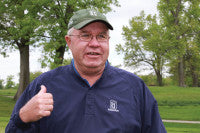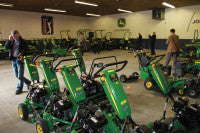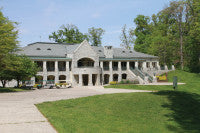The TPC Deere Run - an award winning championship course
 TPC Deere Run has been recognised as one of the top one hundred golf venues in the United States and, since 2000, has been the venue for the John Deere Classic tournament. John Deere is also the official golf course equipment, leasing and landscape supplier to the club.
TPC Deere Run has been recognised as one of the top one hundred golf venues in the United States and, since 2000, has been the venue for the John Deere Classic tournament. John Deere is also the official golf course equipment, leasing and landscape supplier to the club.
TPC Deere Run's golf course is built on the site of a former Arabian horse farm. Illinois native and former PGA Tour professional, D.A. Weibring, masterfully preserved the natural, rolling landscape along the Rock River to create a championship golf course, beautifully framed by oak trees and accented by small ponds and deep ravines. The land's past includes Native American settlements, farming, coal mining and, most recently, one of the top horse and cattle breeding programmes in the country.
Participants in the course design felt that it was important for every visitor to understand the historical significance of this piece of ground - and so they named each hole on the course after the land's rich heritage.
For example, the signature hole at the TPC Deere Run is the 16th and is named "Mother Earth." Views like the ones from the 16th tee represent the types of features  that have drawn people to this property for centuries.
that have drawn people to this property for centuries.
Archeological evidence indicates Native Americans settled and lived on this property as far back as 5,000 years ago. To Native Americans, the land is a living being called Mother Earth, who cares for all her children by providing food, shelter, beauty and a place for contest and play.
The early inhabitants enjoyed many sporting activities. Games ranged from lacrosse, which was played in the summer on the large grassy expanses on the property, to snow snake races in the winter where a crooked stick called the "snake" was thrown down a steep hill as each player attempted to send his snake the farthest. The 16th hole is dedicated to these early inhabitants, to pay tribute to the spirit of respect and competition they first brought to the site.
Paul Grogan is the Director of Golf Course Maintenance Operations who graduated from Purdue University with a BS in Agronomy. He has been in the golf business since 1972. He was Superintendent at Harrison Lake Country Club from 1986 to 1999, before moving to TPC Twin Cities in 2000, and TPC Deere Run in 2006.
 The course was built in 1998 and opened in 2000. The whole site covers almost 400 acres, with approximately 150 acres of its hilliest terrain used for the golf course and related areas, such as practice area, parking and clubhouse.
The course was built in 1998 and opened in 2000. The whole site covers almost 400 acres, with approximately 150 acres of its hilliest terrain used for the golf course and related areas, such as practice area, parking and clubhouse.
The soil type is clay, except tees and greens which are sand base. Drainage and soil profile on the greens are in accordance with USGA specs. Rootzone on greens is 12" to 14". Sand cap on tees is around 6".
A Rainbird irrigation system is installed, covering greens, tees, fairways and rough.
During the season, twenty-six staff are employed, which drops down to around six to eight off season. Usage is not that excessive, with around 22,000 rounds a year, but the course needs to be presented immaculately all year round.
Paul makes most of his own decisions but, if advice is required, he calls on PGA Tour agronomists or various professors at Purdue University.
As you might expect, pretty much all the equipment is John Deere. If it's not JD, it's because they don't make it! A new fleet was purchased this year, and Paul is  particularly impressed with the new JD220E contour greens mower which, he says, has made a significant difference to the quality of the greens. These are mown at 0.115" - we'll keep it as inches for our American cousins!
particularly impressed with the new JD220E contour greens mower which, he says, has made a significant difference to the quality of the greens. These are mown at 0.115" - we'll keep it as inches for our American cousins!
Tees are kept at 0.375" and are cut using a JD220SL. Fairways are maintained at 0.390" with a JD7500 and JD2500. The rough is cut with a JD8800 at 3.00"
Aeration is carried out at various times during the year using a JD Aercore - greens twice, tees two to three times and fairways once. Tine size varies from 0.375 to 0.625"
For the most part Paul uses blended organic fertilisers, treating for dollar spot, brown patch, pythium, and grey and pink snow mold. The club is a member of Audubon Cooperative Sanctuary Program and, therefore, is mindful of what products are used out on the course.
 Rainfall, soil temperatures, surface, soil cores, nutrient status, hardness, thatch, ball bounce and soil pH are measured at various times during the year.
Rainfall, soil temperatures, surface, soil cores, nutrient status, hardness, thatch, ball bounce and soil pH are measured at various times during the year.
Drainage work was undertaken on holes 17 and 18 in 2011, but there is no specific winter work planned for this year, although the team will continue to thin woodlines to improve air movement. Paul continually has problems with enough teeing area on holes 1, 3, 6, 8, 12, 14 and 16, so tee enlarging will become part of the overall renovation programme.
Paul will usually attend the Golf Industry Show and Midwest Turf Foundation Show, both of which, he says, provide good educational programmes and the opportunity to network with his peers.
